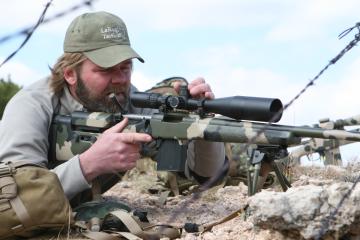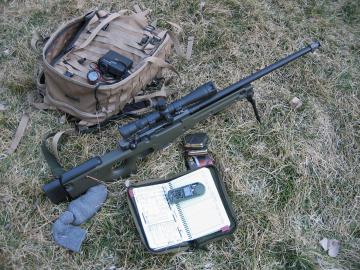Next, it is important the elevation knob be able to provide enough travel to get the bullet to the
maximum distance the rifle can shoot. Thirteen mils or 45 MOA is enough to take nearly any 308 load
to 1000 yards. At Denver altitude, .338 Lapua Magnum takes just over 13 mils to get to 1500 yards.
This is where scope tube diameter comes into play; a larger diameter tube allows more erector
movement, which in turn allows more elevation.

 With only 10 MOA or 5 mils per turn, the Nightforce requires more than one turn of the knob to get
past 500 yards.
Imagine you've dialed up 43 MOA for your 980-yard shot, which happens to be almost three full turns of your
elevation knob, which has 60 fourth-MOA clicks per turn (15 MOA per turn), then forgot to reset
the dial when you left the last shoot position. Now you can't remember exactly which turn your zero
was on. You could easily be one or two full turns off, which is over seven feet error at 500 yards!
Now what? This is where the zero-stop comes in. When you dial down a zero-stop knob, it will
physically stop turning right at or a few clicks under your zero. This physically indicates the
zero, and it is much harder to get lost in knob turns. This feature is often paired with a big,
many-click elevation knob that typically has over 30 MOA or over 11 mils of elevation travel in a
single turn. This allows the shooter to dial out to a 1000-yard shot in less than one turn of the
knob, and adjustments within 500 yards involve about a quarter turn. These big many-click elevation
knobs offer another level of ease of use which reduces human error in the field.
The other thing long-range shooters have to specify is the windage correction, to compensate for
wind drift or target movement. The same considerations apply here as for elevation, except that the

 Long-range shooter Ray Sanchez dials the EREK knob on his USO SN-3 scope before engaging a long
target with his G.A. Precision 7 mm WSM.
amount of travel is not an issue. The reticle is often used for windage hold-off since dialing wind
is an extra step and the shooter can usually hold off up to a mil or two accurately-enough to make
hits for moderate wind values.
Fixed-power scopes such as the 10x Unertl and the original Leupold Mark 4 used to be the only
serious contenders for military-spec sniper scopes due to durability. However, modern high-end
variable magnification scopes have no problem with durability. At low magnification, they provide
higher speed for close target engagements and more low-light capability. Illuminated reticles are a
necessity for low-light shooting, and they are standard on high-end tactical scopes.
How much magnification do you need? The answer is less than you might think. The scope needs to
provide a clear image of the target for a well-defined sight picture. With good glass, a 12x scope
is more than sufficient for 1000-yard shooting. To test the theory, I dialed down my 3-12x50 mm
Schmidt & Bender scope to 4x and was able to make hits on a 36-inch target at 1300 yards; it was
enough to discern the target from the background. A lot of people think they need very high
magnification to shoot at long range, however, as the magnification is increased, the field of view
gets smaller and it is harder to find the target in the scope. Another problem at high power is
that the size of the exit pupil shrinks, which makes eye position a lot more critical for a full
view through the scope. A smaller exit pupil also makes it harder to track the target though

 Along with a solid rifle, accurate ammunition, range-finder, and data-book, a scope with the right
features is key to making long-range hits.
recoil, which is how a shooter can spot his own bullet impacts. At the low end, dialing down the
magnification makes it easier to find close and track moving targets, and provides a brighter image
in low light. So what's the answer?
For practical shooting to about 1000 yards, a top end of 12x to 16x gets the job done and puts the
low end between 3x and 5x for most scopes. Another reason to pick the lowest magnification that
will work for the longest shots is to help limit rifle weight and bulk. I regularly shoot scopes
with maximum magnification of 12x, 15x, and 25x, and I have found that on the bigger models, I
typically dial them down to the 12-15x range to shoot. With clear glass and a good reticle, a 12x
scope is usable as far as 1350 yards on practical targets.
Many balk at spending $1000, not to mention almost $3000, on a rifle scope. This is somewhat
misguided. While you consume ammunition, barrels, calories, and vehicle fuel in training and
practice, the scope, rifle action, and stock are essentially fixed costs. The cost of the
consumables will eclipse the fixed costs in just a year or two, while an optic that provides clear
and bright images while being boringly dependable will pay off every time you pull the trigger.
|